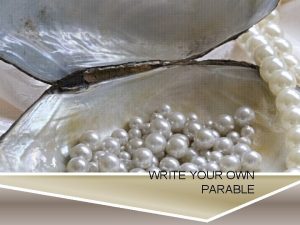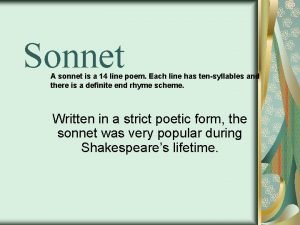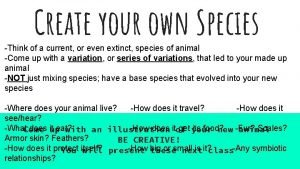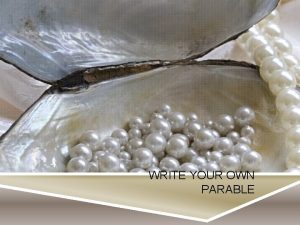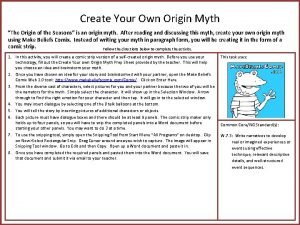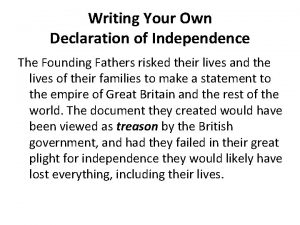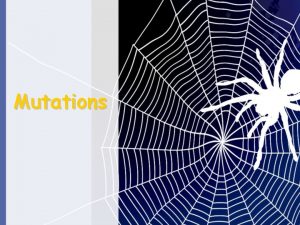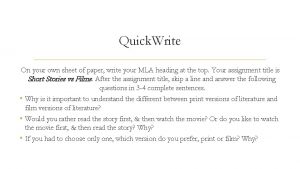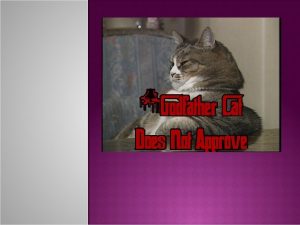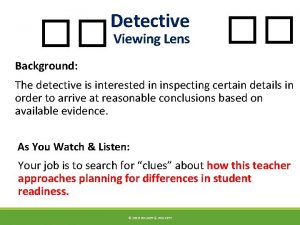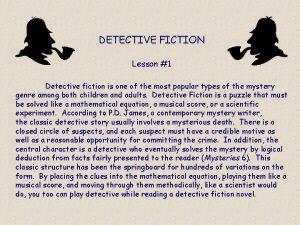Detective Quick Write Create your own detective Characterize
















- Slides: 16

Detective Quick Write Create your own detective. Characterize her or him in two paragraphs, describing your detective both physically and mentally. You may also draw an illustration to accompany your response. Aspects to consider: Name, Age, Nationality Personal history Physical description Habits and Personality Strengths and Weaknesses Unusual features Common saying

The History of Mystery From Edgar Allan Poe to Goosebumps

Edgar Allan Poe: The Father of Mystery ► Born 1809, Died 1849 ► Introduced first fictional detective, Auguste C. Dupin, in his 1841 short story, “Murders in the Rue Morgue” ► “Locked Room” mystery in which a murder victim is found inside an apparently sealed enclosure, and the detective’s challenge is to discover the murderer’s modus operandi (or method of operation) ► Poe shifted emphasis from eerie setting to criminal mind ► Other Poe detective short stories include “The Mystery of Marie Roget” (1842) which was sequel to Rue Morgue and “The Purloined Letter” (1844/1845)

Sir Arthur Conan Doyle: Sherlock Holmes Mysteries ► Born 1859, Died 1930 ► Sherlock Holmes’s debut in 1887 novel, A Study in Scarlet ► Holmes deduced clues to solve crimes ► Solving of crimes became a science

Agatha Christie: The “Golden Age of Mystery Fiction” (1920 s) ► Born 1890, Died 1976 ► Wrote more than 80 novels ► Christie’s most famous detectives: Hercule Poirot and Miss Marple

“The Shadow” brings Mystery to the Radio Airwaves ► Originally named “The Detective Show” ► On the air from 1930 to 1954 (24 years) ► The Shadow was an invincible crime-fighter who could defy gravity, unravel any code, and “cloud men’s minds” ► Never seen, only heard "Who knows what evil lurks in the hearts of men? The Shadow knows!"

Alfred Hitchcock: Mystery Hits the Silver Screen ► Born 1899, Died 1980 ► Writer/Actor/Director of over 50 films, beginning with “Number 13” (1922) ► Explored the notion of terror inflicted on the unknowing (and sometimes innocent) victim ► Other topics: guilt, fear, redemption, obsession

Rod Serling’s “Twilight Zone” ► Born 1924, Died 1975 ► Interest in mysteries from a young age ► Wrote TV dramas in the early 1950’s ► Left to create “The Twilight Zone, ” a science fiction TV series, in 1957

Today’s Mystery Writers ► Joan Lowery Nixon (Nightmare) ► Lois Duncan (I Know What you Did Last Summer) ► R. L. Stein’s Goosebumps series ► John Grisham (Theodore Boone, Kid Lawyer) ► Dan Brown (The Da. Vinci Code) ► Sue Grafton (The Kinsey Millhone Alphabet Series) ► True Detective

Historical Factors and Detective Fiction ► First modern police forces organized in late 1700 s/early 1800 s “responsible only to the law” and not to some wealthy patron ► Rise of democracy (especially in America) gives rise to the belief that law/police are on side of the people ► Genre shift: before, criminal could be seen as heroic (i. e. Robin Hood), but not in this genre ► While some characters might question efficacy of justice (or even possibility of justice through law), ultimately, authors of this genre always side with the ideal of law and order

The “Double Contest” ► At the heart of detective fiction is both the contest of wits between the detective and the villain, but also between the writer and reader ►In good fiction, the writer must “play fair” with the reader (that is, there must be enough reasonable clues in the story for the reader to figure out who done it)

Detective Fiction as Game of Wits Detective fiction developed as a highly structured, formal art with rules: 1. Evidence must be available to the reader 2. The solution must be reasonable (not impossible) 3. No surprises at the end; ex. the number of suspects must be finite 4. Crime should be significant 5. There must be detection not simply a solution.

Elements of Mystery Writing ► mysterious/scary setting, eerie atmosphere, and suspense/tension ► a crime ► a determined sleuth (detective engaged in catching criminal or getting information that is not easily available to solve a mystery) ►a sidekick (sometimes) to help solve the mystery ►obstacles to solving the crime ► clues ► a solution

What’s a Mystery without Clues? When reading a mystery, make a list of clues you may use to solve the mystery. ONE needs to be a CRUCIAL clue--the one piece of information that helps the sleuth finally solve the mystery Example – Stan says he received a strange phone call at eight o’clock at night. Later in the story, the main character researches where all the “suspects” were at eight o’clock, remembers what Stan said, and realizes a phone call to him at that time was impossible… so Stan lied – and is the criminal !

Red Herrings Consider “red herrings” or false clues designed to mislead the readers by making them suspect the wrong characters. The phrase means “camouflage” and comes from the process of curing a herring (type of fish). When a herring is salted and smoked slowly over a wood fire, it turns a dark reddish brown color and gains a strong flavor and scent. The smell is so strong that it overwhelms other scents. According to some old tales, red herrings were pulled across the trail of hounds to confuse and throw them off the trail. Example – Maybe you want to cast suspicion on Stan’s brother, who is seen throughout the story nibbling on cotton candy. The main character might find a set of “sticky” fingerprints on the doorknob of the murder room, leading the readers to suspect Stan’s brother.

The Detective’s Vocabulary ► Alibi: An excuse that a suspect uses to show that he or she was somewhere other than at the scene of the crime ► Breakthrough: A development that advances/solves a case ► Deduce: To derive at a conclusion from something known or assumed; infer ► Evidence: Something that helps prove who committed the crime (may be concrete or circumstantial) ► Motive: The reason(s) why a person commits a crime ► Victim: Someone who is harmed or suffers some loss due to the crime ► Witness: Someone who saw the crime being committed and can provide some information
 What type of sae is when you own your own business
What type of sae is when you own your own business Create your own top level domain
Create your own top level domain My own parable
My own parable 14 line sonnet poem
14 line sonnet poem Coat of arms medieval times
Coat of arms medieval times Create your own species
Create your own species Create your own civilization
Create your own civilization Make your own parable
Make your own parable Create your own tribe
Create your own tribe Create your own propaganda
Create your own propaganda Create your own myth
Create your own myth Make your own declaration of independence
Make your own declaration of independence Create your own weather map online
Create your own weather map online Creating a society project
Creating a society project Create your own planet
Create your own planet Create your own weather forecast template
Create your own weather forecast template Quick find algorithm
Quick find algorithm


